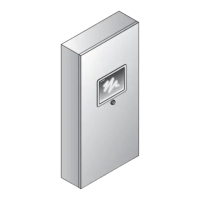18
|
nVent.com/RAYCHEM RAYCHEM-OM-EU2032-NGCUIT3EX-EN-2203
• Input the Ground-Fault Current Alarm and Ground-Fault Current Trip by pressing each of the twonumeric fields in turn
• For this example, the Ground-Fault Current Alarm and Ground-Fault Current Trip levels are set to20 mA and 30 mA respectively
- At less than 20 mA, the NGC-30 program takes no action. At 20 mA or more leakage, an alarm is indicated and logged to the
Events List
- At 30 mA the output relay assigned to this Circuit is tripped off
High
If the voltage monitoring module measures line voltage above this threshold, the NGC-UIT3 generates an alarm.
Range: 50 – 305 V
Default: 270 V
Low
If the voltage monitoring module measures line voltage below this threshold, the NGC-UIT3 generates an alarm.
Range: 50 – 305 V
Default: 90 V
• Input the High Current Alarm and Low Current Alarm by pressing each of the two numeric fields in turn. For this example, High
Current Alarm is set to 30 A, and Low Current Alarm is set to 5 A
A ground-fault alarm means the heating cable has been damaged or improperly installed and must not be ignored.
Disabling the ground-fault trip function reduces safety and could result in sustained electrical arcing or fire. To minimize the risk of fire
if the alarm activates, shut off the power and repair the system immediately
Setting 0 for both High and Low Current Alarms completely deactivates the Current Alarm function.
• Power Limit – This is enabled only when SSR control devices are detected (NGC-30-CRMS panel). A Power Limit setting less
than 100% will limit the “on-time” of a constant wattage heater to the percentage indicated in the entry field. This has the effect of
lowering the amount of power that the heater can produce
Power Limiting is not recommended if self-regulating heaters are installed
Fig. 2.17 Circuit 1 enabled
• By default, once you program a Circuit, it immediately begins to control the heater based on the input information
• If you do not want this Circuit to activate until all Circuits are programmed, go to Setup | Circuit window and press the Enabled
toggle button once, which disables the Circuit. To re-Enable, press the Enable/Disable button again

